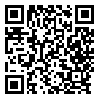شمارۀ جدید فصلنامه (تابستان 1404) منتشر شد
Volume 11, Issue 2 (10-2020)
Social Problems of Iran 2020, 11(2): 237-265 |
Back to browse issues page
Download citation:
BibTeX | RIS | EndNote | Medlars | ProCite | Reference Manager | RefWorks
Send citation to:



BibTeX | RIS | EndNote | Medlars | ProCite | Reference Manager | RefWorks
Send citation to:
Ghanimati H, mansouri F, dadandish P. (2020). Social integration and the relationship of normative plurality with it. Social Problems of Iran. 11(2), 237-265.
URL: http://jspi.khu.ac.ir/article-1-3232-en.html
URL: http://jspi.khu.ac.ir/article-1-3232-en.html
1- Assistant Professor of Public Management, Qazvin Branch, Islamic Azad University, Qazvin, Iran , h-ghanimati@sbu.ac.ir
2- PhD Student in Cultural Policy, Department of Sociology, Kharazmi University, Tehran, Iran. Tehran.
3- Assistant Professor, Department of Political Science, Faculty of Humanities, West Tehran Branch, Islamic Azad University, Tehran, Iran.
2- PhD Student in Cultural Policy, Department of Sociology, Kharazmi University, Tehran, Iran. Tehran.
3- Assistant Professor, Department of Political Science, Faculty of Humanities, West Tehran Branch, Islamic Azad University, Tehran, Iran.
Abstract: (2786 Views)
One of the most important factors affecting social development is the social integration of societies. Sociologists have identified several factors as contributing factors. One of the most important of these is the cultural characteristics of societies, the status of normative plurality or normative conflict and how they are dealt with in societies. Theoretical literature proposes various models of its effect on social integration. This paper argues that societies with greater levels of plurality or normative conflict appear to have lower levels of integration. In order to test this claim, a comparative study was conducted using secondary data. For this purpose, data from WVS, (2015,1995) World Values Survey, Minorities at Risk, International Religious Freedom, Data World Bank and International Institute of Social Studies (ISS) are used. The data period of this study is from 1995 to 2015 covering 109 countries. The results showed that: societies with a high degree of normative plurality or conflict have a low degree of social integration. The form of the relationship between these two variables for both total plurality and Components for its constituents has been almost linear. North American countries had the highest integration and the lowest normative plurality and conflict. And African countries, on the contrary, have a higher degree of normative plurality and conflict and a lower degree of integration. Iran is ranked 87th out of 109 countries in terms of social integration and 31st out of 61 countries in terms of plurality and normative conflict.
Keywords: Cultural characteristics, normative plurality, normative conflict, integration comparative study.
Type of Article: Original Research |
Received: 2020/07/25 | Accepted: 2021/01/19 | Published: 2021/03/14
Received: 2020/07/25 | Accepted: 2021/01/19 | Published: 2021/03/14
References
1. Chalabi, M. (2003). The sociology of order, anatomy and theritical social analysis, Tehran: nashre ney publication. [in fa]
2. Ghanimati, H. (2017). Study of social integration with emphasis on Iran(multiple historical case studies)." Dissertation of Ph.D., Department of Social Sciences, Shahid Beheshti University. [in fa]
3. Mohseni, M. (2000). Studying Socio-Cultural Awareness, Attitudes and Behaviors in Iran, General Culture Council publication. [in fa]
4. Blattman,C & Miguel,E.(2010). Civil War." Journal of Economic Literature, 48(1):3-57. [DOI:10.1257/jel.48.1.3]
5. Breidahl, K., Holtug, N., & Kongshøj, K. (2018). Do shared values promote social cohesion? If so, which? Evidence from Denmark. European Political Science Review, 10(1), 97-118. [DOI:10.1017/S1755773916000266]
6. Camilla Pagani (2014). Diversity and social cohesion, Intercultural Education,25:4, 300-311, [DOI:10.1080/14675986.2014.926158]
7. Chai, S.K & Hechter, M.(1998). A theory of the state and of Social order: Chapter 2 in Dreian, P & Fararo, T. J (eds) the problem of solidarity: Theories and models. New York: Gordon and Breach Publisher.
8. Collins, R. (2003). Emotional Energy and the transient emotions", Chapter 3 in interaction ritual chains. Princeton: Princeton University Press.
9. Collins, R.(1995). Prediction in Macrosociology: The Case of the Soviet Collapse." American Journal of Sociology, 100(6), 1552-1593 [DOI:10.1086/230672]
10. Collins, R. Hanneman, R.(1998). Modeling The Interaction Ritual Theory Of solidarity." In Dreian, P & Fararo, T.(eds) the problem of solidarity: Theories and models." New York: Gordon and Breach.
11. Dragolov G., Ignácz Z.S., Lorenz J., Delhey J., Boehnke K., Unzicker K. (2016). Theoretical Framework of the Social Cohesion Radar. In: Social Cohesion in the Western World. SpringerBriefs in Well-Being and Quality of Life Research. Springer, Cham [DOI:10.1007/978-3-319-32464-7_1]
12. Ellis, D. (1971). The Hobbesian Problem of Order: A Critical Appraisal of the Normative Solution." American Sociological Review, 36: 692-703. [DOI:10.2307/2093599]
13. Elster, J. (1989). The Cement of Society: A Survey of Social Order (Studies in Rationality and Social Change). Cambridge: Cambridge University Press. [DOI:10.1017/CBO9780511624995]
14. Fararo, T.J & Dreian, P.(1998). The theory of solidarity: an genda of problems": Chapter 1 in Dreian, P & Fararo, T. J (eds) the problem of solidarity: Theories and models. New York: Gordon and Breach Publisher.
15. Fonseca, X. Lukosch, S. , Brazier,F,. (2019). Social cohesion revisited: a new definition and how to characterize it, Innovation: The European Journal of Social Science Research, 32:2, 231-253 [DOI:10.1080/13511610.2018.1497480]
16. Goldstone, J.(1991). Ideology, Cultural Frameworks, and the Process of Revolution." Theory and Society, 20(4), 405-453. [DOI:10.1007/BF00157321]
17. Heise, D. R.(1998). Conditions for Empathic Solidarity.", Chapter 3 in Dreian, P & Fararo, T. J (eds) the problem of solidarity: Theories and models. New York: Gordon and Breach Publisher.
18. Helly, D., Barsky, R., & Foxen, P. (2003). Social Cohesion and Cultural Plurality. The Canadian Journal of Sociology, 28(1), 19-42. [DOI:10.2307/3341873]
19. Hogg, M. A & Vaughan, M.G.(2002). Social Psychology. London: Prentice Hall Press.
20. Hogg, M. A.(1992). The social psychology of group cohesiveness: From attraction to social identity. New York: New York University Press.
21. Horowitz, D. L.(1998). Structure and Strategy in Ethnic Conflict. Publisher: World Bank.
22. International Institute of Social Studies (ISS).
23. Jenson, J., (2019). Intersections of Pluralism and Social Cohesion, Global Centre for Pluralism
24. Jenson, J., (1988). Mapping Social Cohesion: The State of Canadian Research. 1st Edn. Canadian Policy Research Networks, Ottawa, ISBN-10: 1896703313, pp: 48
25. Kaufmann, D. Kraay, A. and Pablo Zoido-Lobaton. (1999). Governance Matters, Policy Working Paper 2196, Development Economics Group, World Bank.
26. Kaufmann, D. Kraay, A. and Massimo Maastruzzi. (2006). Measuring Corruption: Myths and Realities, Development Outreach
27. Kymlicka W. (1995). Multicultural citizenship. Oxford: Oxford University Press. [DOI:10.1093/0198290918.001.0001]
28. Kolstø, Pål; Tyldum, Guri, (2006).Common Values and Social Cohesion in Ethnically Divided Societies" Ethnicity Studies / Etniskumo Studijos .Issue 1, p121-146. 26p
29. Li, R. S. K.(2002). Alternative Routes to State Breakdown: Toward an Integrated Model of Territorial Disintegration, Sociological Theory, 20:1-23. [DOI:10.1111/1467-9558.00148]
30. Markvosky, B & Lawler, E. J.(1994). A new theory of group solidarity, in Markvosky, B & O'Brien, J & Heimer, K (eds.), Advances in Group Processes,11: 113-137
31. McPherson, M., & Smith-Lovin, L.(2002), "Cohesion and membership duration: Linking groups, relations and individuals in an ecology of affiliation.", in (ed.) Advances in Group Processes, 19: 1 - 36 [DOI:10.1016/S0882-6145(02)19002-3]
32. Mekoa, Itumeleng & Busari, Dauda. (2018).Social Cohesion: Its Meaning and Complexities, Journal of Social Sciences. 14. 107-115 [DOI:10.3844/jssp.2018.107.115]
33. Parton, B. (2011). Stability for Development, Development for Stability: The Relationship Between Regional Organizations and Social Cohesion Through the Lens of the EU and MERCOSUR, Peabody Journal of Education, 86(2), 129-143. [DOI:10.1080/0161956X.2011.561175]
34. Portes, A., & Vickstrom, E. (2011). Diversity, Social Capital, and Cohesion". Annual Review of Sociology, 37, 461-479. [DOI:10.1146/annurev-soc-081309-150022]
35. Scheff, T. J.(1967). A theory of social coordination applicable to mixed-motive games. Sociometry, 30(3), 215-234. [DOI:10.2307/2786445]
36. Schiefer, D., van der Noll, J., (2017). The Essentials of Social Cohesion: A Literature Review, Soc Indic Res 132, 579-603 [DOI:10.1007/s11205-016-1314-5]
37. Scott, S & Marshall, G.(1998). A Dictionary of Sociology. New York: Oxford University Press.
38. Skocpol, T.(1994). Social Revolutions in the Modern World. Cambridge Studies in Comparative Politics. Cambridge, England: Cambridge University Press. [DOI:10.1017/CBO9781139173834]
39. Spicker, P. (2014). Cohesion, Exclusion and Social Quality. The International Journal of Social Quality, 4(1), 95-107. [DOI:10.3167/IJSQ.2014.040107]
40. Stanley, M (2017). Sociological Perspectives on Social Cohesion as the Principal Requirement for Social Stability, South African Review of Sociology, 48:3, 84-98 [DOI:10.1080/21528586.2017.1299040]
41. Tajfel, H., & Turner, J.(1979). An integrative theory of intergroup conflict, Chapter 3 in Austin, G. W. & Worchel, S. (eds) The social psychology of intergroup relations, Brooks/Cole Pub. Co
42. Tajfel, H., & Wilkes, H.(1963). Classification and Quantitative Judgment, British Journal of Psychology, 54, 101-114. [DOI:10.1111/j.2044-8295.1963.tb00865.x]
43. Turner, H. J.(2006). Handbook of Sociological Theory. New York: Springer
44. Turner, B. S. & Rojek, C.(2001). Theory, Culture & Society: Society and culture: Principles of scarcity and solidarity London: SAGE Publications Ltd
45. Turner, J. C.(1985). Social categorization and the self-concept: a social cognitive theory of group behavior, In E. J. Lawler (ed.~). Advances in Group Processes. 2: 77-122.
46. United Nations.(2005). The Inequality Predicament, United Nations
47. White, D. R. & Harary, F.(2001). The cohesiveness of blocks in social networks: Node connectivity and conditional density, Sociological Methodology, 31: 305-359. [DOI:10.1111/0081-1750.00098]
48. www.World Values Survey(WVS)
49. www.data.worldbank.org/indicator/
50. www.cidcm.umd.edu/mar
Send email to the article author
| Rights and permissions | |
 |
This work is licensed under a Creative Commons Attribution-NonCommercial 4.0 International License. |







